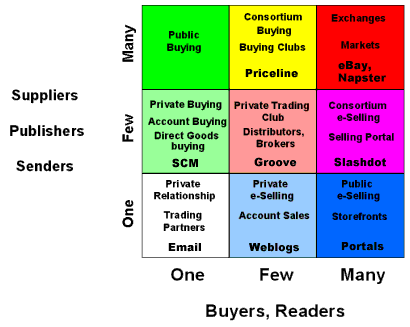If we draw this up as in the chart below, we can classify 9 different scenarios. Clearly the boundaries of the cells are somewhat blurred, but the distinctions should be clear.

Take the white square in the bottom left. This represents a private trading relationship between two companies, probably using technology like EDI. So-called “Private Markets” are typically few to one as private e-Procurement or one to few as private e-Selling to known accounts (The pale green and pale blue squares respectively). The true private exchange is in the middle square, where a small number of buyers and sellers transact with each other, but membership is restricted. Many of the traditional exchanges actually work like this where you have to buy a seat on the exchange. Distributors and brokers also sit here as they both buy and sell but only with partners that have a mutual account. The top right, red square is the open market such as eBay. Here, anybody who satisfies some basic requirements can post both buy and sell orders. This analysis helps us to get away from broad generalizations about “Private Markets”. We can now see that there are at least four distinct types of Private Market. As a result of this we can get a better understanding of the sort of function required by each area and hence appropriate software to use.
This approach can be applied to many other systems apart from B2B. For instance an analysis of publishing could be done comparing magazine sites (like Wired, one to many), a collection of personal websites (like Geocities, few to many) and user driven news sites (like Slashdot, many to many). Another example might be music distribution with Record Companies, Radio Stations, Music publishing websites and Napster occupying distinct places on the chart.
[ << Proper motorcycling attire ] [ De-Centralization in B2B >> ]
[ 0 comments ] [ G ] [ # ]




